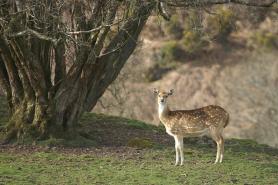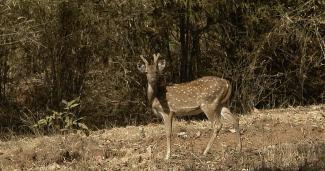Axis
Axis or Chital Axis axis
Measurements; Head-Body Length-110 to 140 cm Shoulder height- 95 cm Tail length- 20 to 30 cm Weight- 75 to 100 kg |
Physical Appearance
Axis Deer are also commonly known as Chital or as the Spotted Deer. It is a large species of deer, which has a particularly elegant and charming appearance. Axis deer are relatively high legged, with thick necks and long heads. Males are larger in size than the females and have thicker necks and chests. Males are darker in colour, especially around the head and face, and this darkening becomes more pronounced with increasing age.
The coat is distinctive being a rich dark brown coloured with numerous white spots running in rows along the flanks. There is a dark black stripe of fur that runs down the spine. The under parts, insides of the legs, and the lower throat are white. The nose and eyes are dark in colour; the eyelashes are long and especially noticeable. The muzzle and face is often darker in colour than the body, and sometimes has black markings. The tail is long and has a white underside.
Only the males carry antlers. These grow in a lyre like shape and can be up to 76 cm long. Typically these have only three tines each, meaning that is total the antlers have 6 tines. The antlers are carried low, and have a strong front prong; the backwards-pointing prong is long and ends in a fork. The antlers are usually shed annually, but because this is a tropical living species there is no specific season in which they are lost.
Distribution
Axis deer occur throughout the Indian subcontinent and the island of Sri Lanka. They are abundant in India and one of the most common species of deer found there.
They have also been introduced into a number of European countries, New Zealand, Australia, and the United States. In Europe numbers are small, mainly because they are not particularly hardy and suffer in the cold winters that occur here. Large numbers are kept in the United States, especially in Texas, where they are used for ranching purposes.
Diet
Grass makes up a large proportion of the diet, but they also feed on herbaceous plants and browse on twigs and leaves.
Lifespan
Chital have a lifespan of up to 9 to 12 years in the wild, although many fall prey to predators before they reach this age. In captivity they can live for over 20 years.
Reproduction
The mating season varies depending on where they are found. In more tropical areas of India there is no distinct mating season and breeding can take place throughout the year. In areas with more seasonal climates there will be a distinct breeding season. During the mating season males compete with each other for the possession of small groups of females known as harems. Males will compete with each other using bellowing, and sometimes fighting using their antlers. Usually the strongest most dominant males obtain harems and so get to mate.
The females have a 220-day long gestation period, after which normally a single calf is born, although twins can also sometimes occur. The calf is weaned at 6 months of age, and becomes sexually mature from 12 months of age.
Behaviour
Because Axis deer prefer open grassy habitats, they are often found close to agricultural areas or human settlements. Humans have created the conditions they most like, and this has helped to increase their numbers. However, they may become threatened in the future because of increased hunting and a loss of habitat caused by the need for more agricultural land to feed the growing Indian population.
Axis deer are shy and secretive. They have a number of predators including the tiger and leopard. They are a social species, living in small herds of 20 to 30 animals. Sometimes larger herds may form with up to 100 animals, but these are quite rare. herds are led by a few dominant individuals who decide where the herd will feed and rest. Older males tend to be more solitary. While the other main species of Deer in India, the Sambar is purely nocturnal; the Chital can be active throughout either the day or night.
© 2005 Mark Walker, Siegen


